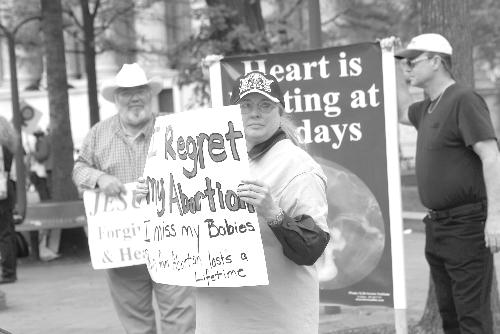
Deconstructing Elena
“I think we might have ended the campaign a little early,” Harvard Right to Life (HRL) President Meghan E. Grizzle ’07 said two weeks ago to her staff of pro-lifers sitting around a table in Leverett’s private dining room. The subject of this prematurely aborted campaign? A highly stylized and now infamous fetus named “Elena.”
It was only a few weeks ago that House open-lists were raging over pictures of a growing fetus professing to have 46 chromosomes, early signs of exceptional hand-eye coordination, and a desire to be a racecar driver. And as the e-mail battles ensued, it became apparent that HRL had succeeded in what they were attempting to do: generate a dialogue about abortion.
In a period on campus where pro-choice groups were nowhere to be seen in response to the legislation in South Dakota—a proposed bill effectively banning abortion (and a potential first step in overturning Roe vs. Wade)—“Elena” filled just that void. HRL’s highly visible message on abortion, plastered in entryway stairwells and on dining hall doors everywhere, was the fodder that resparked an old debate.
The Crimson began running Op-ed pieces on abortion—inspiring several students and alumni to respond via letters—Students for Choice (SFC) reorganized and brought in new leadership, and a group of students from both the pro-life and pro-choice sides recently established the Abortion Policy Group Study at the IOP, whose findings are soon to be published. But as the on-campus debate slowly began, the “poster child” for abortion suddenly disappeared.
MISSION ABORTED
“I agree, it was too soon,” HRL member Justin S. Murray ’07 concurred with Grizzle. “It could have gone a couple more weeks.”
Yet for some students, “Elena’s” abortion could not have come any sooner.
“Those posters are factually inaccurate, total misrepresentations,” SFC Co-Director Rebecca P. Buckwalter ’08 says. “A 25-day-old fetus race car driver,” —she pauses and sighs— “does not even dignify a response.”
Buckwalter, along with her freshman counterpart, SFC Co-Director Melissa S. Ader ’09, have rejuvenated the Students for Choice organization, which until recently was conspicuously missing-in-action.
Buckwalter’s involvement in the issue does not stop with SFC. She spent last summer studying sexual education at the University of North Carolina Government School and took the fall semester off to work as an intern and personal assistant to renowned Democratic political consultant and author, James Carville.
Despite her time spent with Carville, however, Buckwalter has yet to master her marketing tactics and penchant for catchy phrases. Even the revamped SFC has failed to garner the amount of attention that now follows HRL. Though, not everyone wants that type of recognition.
FETAL FIREPOWER
“No publicity is bad publicity was HRL’s old motto,” Grizzle explains. Last semester, for example, HRL put up posters stating that more African-Americans are killed by abortions than any other cause. Perhaps, for HRL, the old adage is true—if inflammatory statements lead to increased awareness, then so be it.
Not everyone agrees.
The “Elena” campaign has been criticized for the potential pain it has caused students who have had an abortion, or are close to someone who has. As Ader explains, “they really create an uncomfortable atmosphere [on campus].” According to Ader, rather than dealing with the topic in a intellectual manner, they “have done more to sensationalize the topic” than anything else.
“It’s something not talked about [abortions], but it happens on campus,” Jason D. Misium ’08, founder of the Abortion Policy Group, explains. There is a reason why these posters get torn down—and not just by students. “Some faculty members will occasionally do it,” Misium notes.
Though as Murray jokes, “if we put a picture of a puppy on a HRL poster, they would tear it down.” According to Murray, HRL took the same light-hearted attitude with designing these posters. “Some of the statements are meant to be taken as fact; some, meant to be taken as humour.”
After all, there are no pictures of a bloody fetus or Bible quotes saying how all sinners will burn in the lake of fire—the staple components to pro-life advertisement. In fact, Murray saw this poster as a sort of “feminist statement...that a girl can grow up to be a racecar driver.”
Feminist arguments aside, Elena was a highly visible reminder of the potential in a bundle of cells. An unassuming fetus has somehow become the well-known public face of HRL.
“Harvard being such a liberal school, we’re a point of view that doesn’t get expressed that often on campus,” Grizzle explains. And thus HRL is pleased to have had this affect. “We’re not going to ban abortion on campus, we just want to show that there are alternatives.”
HRL does more than make posters. They run toy drives with neighborhood churches, make mother’s day cards for community organizations, and put on the annual Cemetery of Innocence, a display of crosses in front of the Science Center depicting lives loss from abortion: all “non-violent, peaceful” ways of spreading the pro-life word, Grizzle says.
The exact definition of the term pro-life word, however, can get a little hazy. A recent SFC poster claiming safe, legal abortions could save a life every 6 minutes, purports the SFC catch-phrase: “Pro-life? So are we.” Elena has done her duty of generating debate, and both sides of the issue claim to be pro-life. With the creation of the Abortion Policy Group, housing both leaders of SFC and HRL, perhaps a more unified end can be reached.
Or perhaps not. At a recent meeting, someone brought up that the use of condoms and a comprehensive sexual education would be the only way to preclude abortions. Grizzle’s response was “but I don’t believe in pre-marital sex.” But at least, thanks in part to a now absent, fictional fetus, they’re talking.


